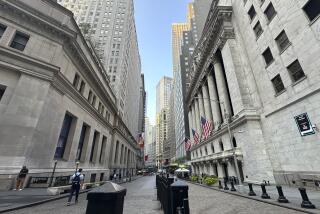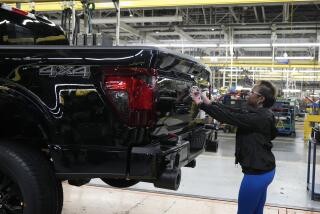Growth in 2nd Quarter Up an Unexpected 5.2%
WASHINGTON — The U.S. economy grew substantially faster than expected this spring, extending good times for most Americans but raising some doubt about whether policymakers can throttle it back to a sustainable pace.
The economy grew at an annual rate of 5.2% from April through June, according to figures released Friday by the Commerce Department. That is a full percentage point faster than most economists had predicted and faster than the revised 4.8% rate at which it expanded from January through March.
The economy’s strong performance caught some analysts by surprise, coming after statistics indicating that consumers might be wrapping up their long spending spree and after Federal Reserve Chairman Alan Greenspan voiced increasing confidence that growth is headed for a less inflation-prone course.
In fact, the new growth figures showed that some of the very trends Greenspan & Co. are seeking seem to be taking hold. Consumer spending, which has been driving the nation’s record boom, grew a mere 3% in the second quarter, less than half the 7.6% rate of the first quarter.
Much of the growth during the April-June period was due to investment by business rather than spending by consumers, which is what economists like to see. Fixed investments by business grew at a 19.1% rate, only slightly slower than the 21% rate of the first quarter.
“Consumption has cooled without weakening the economy,” said Richard B. Hoey, chief economist with Dreyfus Corp. in New York.
Still, the new figures show that the nation has yet to come in for the “soft landing” of not-too-strong and not-too-weak growth that the Fed is trying to orchestrate.
The figures boosted the odds that the central bank will raise interest rates again, either at the Aug. 22 meeting of its policymaking body or at the Oct. 3 session. The Fed has raised rates six times in the last year in an effort to slow growth and, with it, the risk of inflation.
“It makes the Fed’s decision a closer call,” said David M. Jones, chief economist at Aubrey G. Lanston & Co. “They’re going to be watching for any sign the consumer [spending] slowdown is temporary,” Jones said.
The quarter’s higher-than-expected growth occurred without igniting higher inflation. The personal consumption expenditure price index, an inflation measure that is carefully watched by the Fed, rose at a 2.3% rate from April through June, substantially slower than the 3.5% increase from January through March, the Commerce Department said.
Ultimately, the most important effect of the new growth figures may be political rather than economic. Analysts have long observed that strong growth in the second quarter of a presidential year helps the incumbent party’s candidate, while weak growth helps the challenging party. Even some Republicans conceded Friday that the new numbers were good news for Vice President Al Gore.
President Clinton sought to ram home the political implications, praising the “vigorous” spring growth, claiming credit for Democrats and blasting Republicans for what he described as growth-threatening tax-cut proposals.
“This is . . . further confirmation that we are on the right economic path, with stronger and steadier growth than at any time since the 1960s, with 22 million new jobs and the lowest unemployment rate in over 30 years,” Clinton said.
“This . . . is more proof that we should stay on the path of fiscal discipline and not endanger our prosperity by passing one expensive tax cut after another,” Clinton said.
Stock and bond prices tumbled immediately following the announcement of the new growth figures. But analysts said stocks’ losses were mostly the result of disappointing earnings and fears about weaker, rather than stronger, growth.
The Commerce Department said that a boost in business inventories accounted for almost a full percentage point of the second quarter’s 5.2% growth rate.
Analysts interpreted the rise as evidence that companies kept producing items even as consumers bought less. If they are correct, it suggests the spring’s strong growth figure was more the result of a transitory mismatch of supply and demand than a continued booming economy.
*
Times staff writer James Gerstenzang in Washington contributed to this report.
(BEGIN TEXT OF INFOBOX / INFOGRAPHIC)
GROSS DOMESTIC PRODUCT Gross Domestic Product
Percentage change from previous quarter, annualized real rate: 2nd quarter: +5.2%
More to Read
Inside the business of entertainment
The Wide Shot brings you news, analysis and insights on everything from streaming wars to production — and what it all means for the future.
You may occasionally receive promotional content from the Los Angeles Times.










